Introduction to digital transformation

Digital transformation as a profound shift in how an organization operates and delivers value to its customers.
It’s about leveraging digital technologies to modify or create new business processes, culture, and customer experiences.
According to a 2020 report from the International Data Corporation, global spending on digital transformation was predicted to reach $2.3 trillion in 2023, which indicates the significant importance businesses worldwide attach to this process.
However, digital transformation isn’t one-size-fits-all.
The approach varies widely based on the specific needs, goals, and structure of an organization. For example, a government agency might focus on digitizing records and streamlining citizen services, which could involve implementing an online platform to allow residents to pay taxes or renew licenses.
In contrast, an enterprise company might concentrate on developing digital products, utilizing cloud computing, or adopting advanced analytics to improve decision-making and operations.
In fact, according to a 2019 survey by Gartner, government CIOs were seen to focus 29% of their digital services budget on digital initiatives, such as making government services available online.
Comparatively, an enterprise company might put a more significant portion of their budget into digital customer interfaces and data analytics.
A 2020 Mckinsey survey found that 85% of companies accelerated their digitization of customer interactions due to the Covid-19 pandemic, with 67% increasing automation and AI investment.
It’s clear from these statistics that every organization will have a unique journey towards digital transformation.
The key is to ensure that the transformation aligns with the organization’s objectives and adds real value to its customers, stakeholders, and employees.
[If you’re short on time – watch the digital transformation video below]:
In this article, we will explore the concept of digital transformation in 2023 in more detail, including its importance for both employees and customers, its benefits, and how it has evolved in response to recent challenges, such as the COVID-19 pandemic, the Russia-Ukraine war, the “new normal” and the economic recession.
What is DX? (digital transformation)
By using “DX” to signify Digital Transformation, we are drawing on the English language convention of abbreviating “transformation” as “X-formation.” Shortening this phrase has allowed businesses to quickly and easily communicate their vision for digital transformation.

The term “X-formation” is derived from the Latin word “trans,” meaning change or exceed. This connotation of crossing over is reflected in its shortened version, which replaced “trans” with an X. Therefore, the ‘X’ denotes transformation as it symbolizes a journey to something new and improved.
Why Is Digital Transformation Important?
Before COVID-19 struck, digital transformation was mainly dedicated to improving customer service. However, shortly after the pandemic began, everything changed rapidly, and digital transformation quickly became a priority for organizations looking to achieve operational efficiency and fuel innovation.
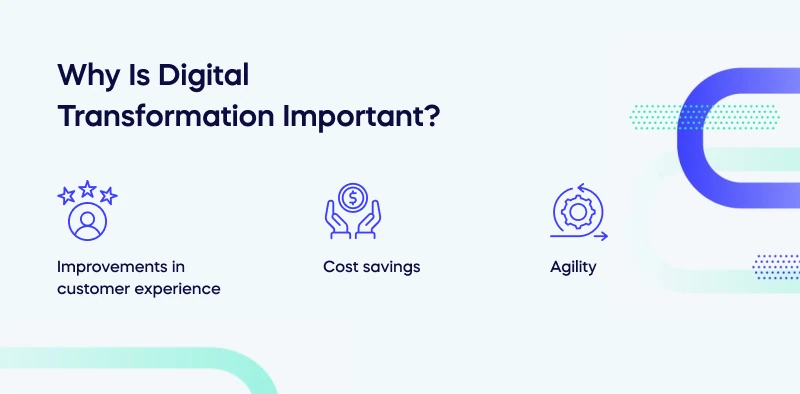
With the rapid speed of change in all industries, CEOs, and CIOs understand the pressure to stay ahead and recognize it as an opportunity for their entire organization. Accelerated digital transformation, such as cloud computing and data, has become the primary item on C-Suite agendas since COVID began.
Organizations that leveraged the right tools and technologies experienced significant improvements in customer experience, cost savings, and agility. This is because digital transformation allowed them to rapidly shift their operations, respond quickly to customer needs, and build efficient workflows that laid the foundation for growth.
Okta is a perfect example of DX early adopters.
We were early adopters of this digital transformation journey…We were in a very fortunate position of what we call a dynamic work initiative. I refer to dynamic work as remote work on steroids. It is becoming fully distributed and really dynamic beyond not just having people physically located in an office
The 7 Drivers for Digital Transformation in 2023
Digital transformation is the process of leveraging new technologies and digital tools to improve business outcomes. The 7 main digital transformation drivers are:
- New Business Models
- Enhance Customer Experiences
- Modernizing IT Infrastructure
- Operational Efficiency
- Upgraded Employee Skillset
- External Partner Collaboration
- Data-Driven decision-making
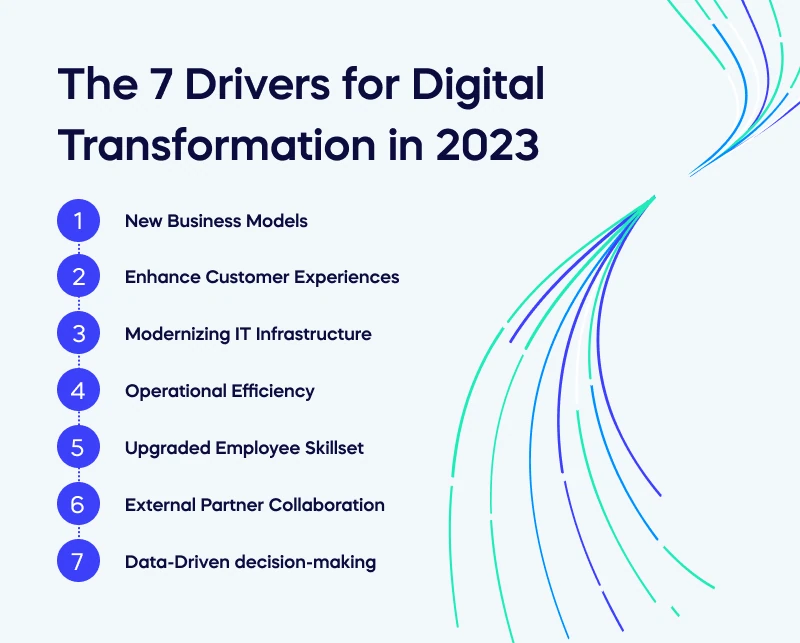
Digital adoption is a vital part of digital transformation, which involves internalizing and utilizing new technologies and tools by teams throughout the company. Organizations can ensure that their digital transformation initiatives are successful by training employees, improving processes, and leveraging data collection methods.
New Business Models – Staying ahead of the digital curve and developing cutting-edge products, services, or delivery channels is essential to any organization’s success. Moreover, it provides a valuable way for organizations to compete with their own existing product lines and offerings.
Enhanced Customer Experiences – Customers and employees have grown accustomed to a certain level of convenience in their day-to-day activities. Whether they are making purchases online, streaming videos, or banking on mobile devices – the same expectations exist when using products, services, and platforms at work.
Modernizing IT Infrastructure – Even though legacy IT infrastructure, obsolete technology applications, and systems reaching their lifespan have become critical aspects of daily operations in most organizations, they remain obstacles to scalability, support, interoperability, and growth.
Operational Efficiency – Every branch in the organization creates its traditional business procedures for internal and external interaction as time passes. These operations often include manual contact, complex authorization protocols and are likely to contain manual mistakes.
Upgraded Employee Skillset – Long-term employees are typically not current on the latest systems, technologies, or digital ecosystems. So if any organization wants to undergo a successful digital transformation journey, it must invest in upgrading its existing employee’s skills through seminars, training sessions, and certifications.
External Partner Collaboration – Strong integration with various stakeholders such as partners, vendors, suppliers, and marketing and delivery channels is essential for a successful digital business model.
Data-Driven Decision-Making – In a world of digital systems, data is king. Not only does this information store records, but it can also trace the development of operations, report on what happened in the past and perform “what if” analysis to anticipate outcomes.
How to enable digital transformation in 6 steps
Companies understand that digital transformations are essential to staying competitive in the current landscape. Common inquiries range from “What’s the best way to begin?” “who are the digital transformation enablers?” and “Where do I start my journey?” to “How can I acquire adequate funds for this project?”. To help organizations on their path of digital transformation, it’s crucial to find solutions that fit their budget and strategic goals.
The six steps to enable digital transformation include:
- Look at it as a shift in business operations
- Strategically craft your organizational transformation
- Dismantle any obstacles that impede transformation
- Foster a mutually beneficial relationship with your partners
- Adopt an agile approach
- Invest for long-term returns
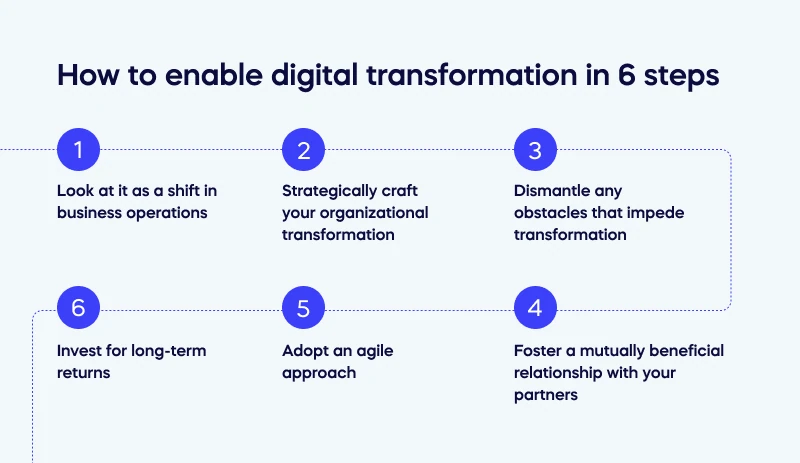
To create real change, follow these six actionable steps that can help provide answers to those queries:
Look at it as a shift in business operations – Companies should make customers the epicenter of any transformation they undertake in response to drastic changes in the market. To ensure success, start by recognizing potential points of friction that might arise throughout equipment sales, parts distribution, and service provisioning – across industries.
Strategically craft your organizational transformation – To efficiently achieve success in any metamorphosis, having a vivid vision, an amalgamated strategy, and adherence to value is essential.
Dismantle any obstacles that impede transformation – Functional silos can be broken down by concentrating on customer issues to create an optimal and successful customer experience. To accomplish this, different departments must collaborate and share data.
Foster a mutually beneficial relationship with your partners – Partnering with other organizations is a great way to access innovative solutions. Such collaborations are also beneficial for forming balanced and cost-effective partnerships.
Adopt an agile approach – To successfully achieve transformation, being agile is essential. It begins by creating a business environment that fosters experimentation and encourages innovative thinking to take root and thrive.
Invest for long-term returns – To seamlessly fund digital transformation, it is best to break the process down into easily achievable steps. To begin with, map out your organization’s digital opportunities and requirements across customer touchpoints in one comprehensive view.
4 main areas of digital business transformation
So how does digital transformation come into play in business? It’s not just about adding technology. Digital business transformation is about organizational change and learning to use technology to improve performance.
The use of AMPs (analytical, mobile tools and applications, and platforms) has exploded and is completely changing business and competitive dynamics within many industries.
When it comes to digital transformation, there are 4 main areas:
- Process Transformation involves reworking processes, using APIs, data, analytics, machine learning, and other technologies to reinvent corporate processes.
- Business Model Transformation is rethinking and reforming an organization’s business model to create a more competitive advantage and achieve greater profitability.
- Domain Transformation is changing a system from one domain to another. It is often used to change a system from a physical domain to an abstract domain, such as a mathematical model.
- Cultural/Organizational Transformation is changing a culture or organization to enhance its effectiveness and adaptability to new challenges and opportunities.
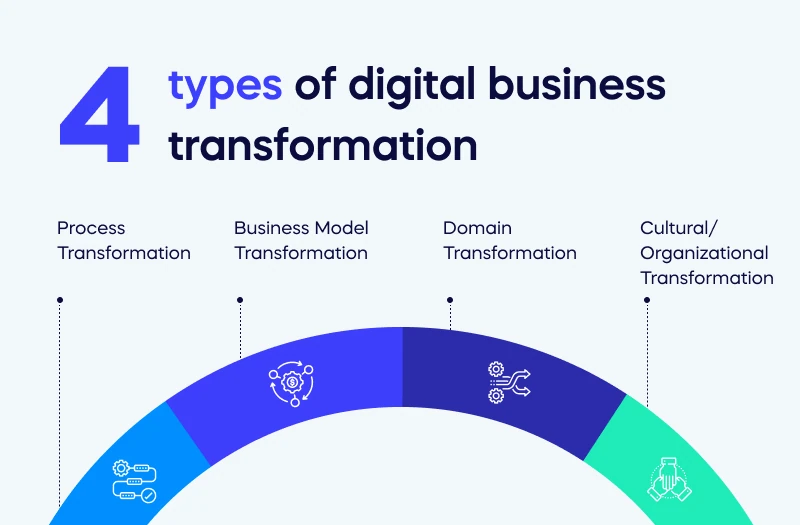
Digital transformation by industry
What are the success rates across sectors and industries when it comes to digital transformation initiatives?
Different sectors and industries have their own unique challenges when it comes to digital transformation. For some, the challenge may be in changing entrenched processes. For others, it may be accessing the resources needed to implement change.
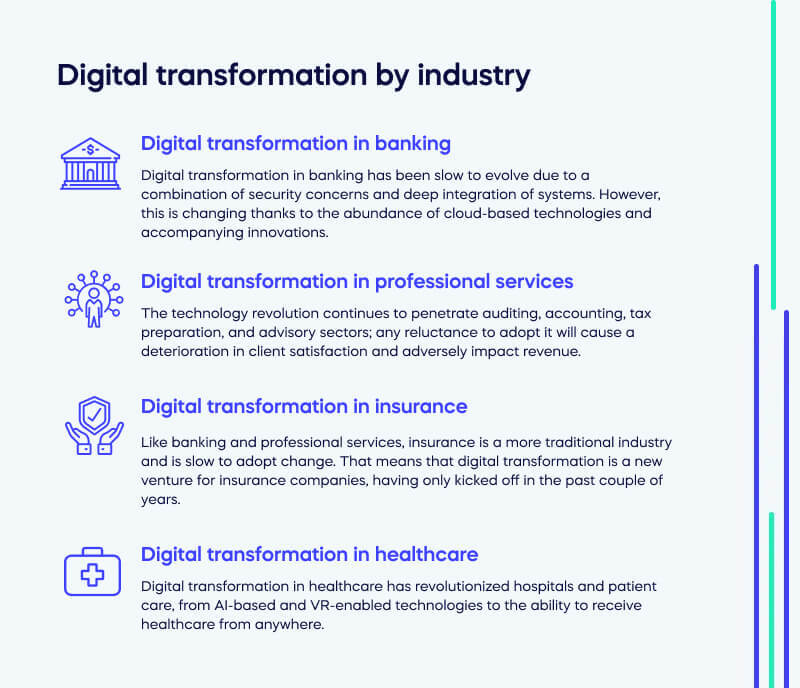
Let’s take a closer look at how some major industries are faring with digital transformation in 2023:
Digital transformation in banking
Digital transformation in banking has been slow to evolve due to a combination of security concerns and deep integration of systems. However, this is changing thanks to the abundance of cloud-based technologies and accompanying innovations. Banking will continue to transform, albeit slower than some other industries.
Digital transformation in professional services
Digital transformation is gradually changing the professional services industry, which traditionally has prioritized personal know-how, billable hours, and customer relationships. The technology revolution continues to penetrate auditing, accounting, tax preparation, and advisory sectors; any reluctance to adopt it will cause a deterioration in client satisfaction and adversely impact revenue.
Digital transformation in insurance
Like banking and professional services, insurance is a more traditional industry and is slow to adopt change. That means that digital transformation is a new venture for insurance companies, having only kicked off in the past couple of years. According to Gartner, CIOs in the insurance industry invest 56% of their budgets on modernizing legacy applications, reflecting the industry’s preference for upgrading rather than replacing legacy systems.
Digital transformation in healthcare
Digital transformation in healthcare has revolutionized hospitals and patient care, from AI-based and VR-enabled technologies to the ability to receive healthcare from anywhere. It has also created commercial opportunities for the wearable devices market, which has skyrocketed in recent years.
Examples of enterprise digital transformation
When scaling digital transformation efforts across an enterprise, we have learned that a holistic approach works best. The full value of digital transformation cannot be realized if it touches only a few mission-critical applications since such a limited scope makes it impossible to measure impact across workflows.
Enterprise digital transformation articles include advice on how to build cross-organizational support for digital transformation initiatives. Leaders must be clear about value delivery, the role of IT teams in supporting the initiatives, and a plan to measure the success of their digital transformation efforts.
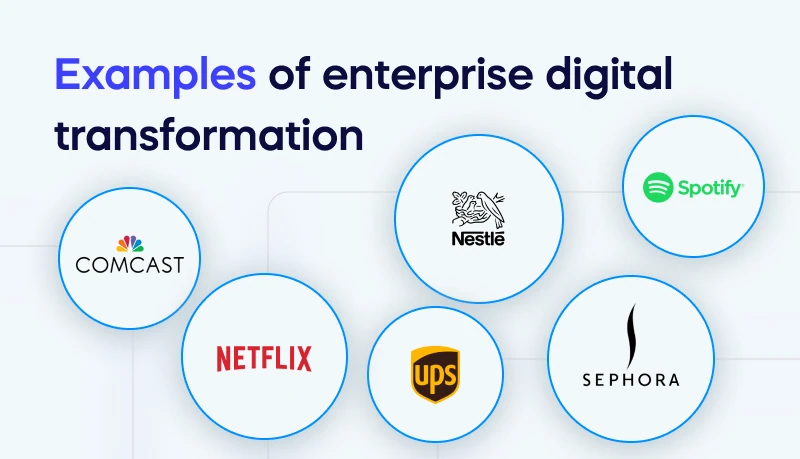
Mega enterprises, including Comcast, Netflix, Nestle, Spotify, Sephora, and UPS, have achieved successful digital transformation through large-scale projects centered around crafting exceptional experiences for employees and customers based on actionable data.
Digital transformation strategy
An organization undertakes a digital transformation strategy to use digital technology and tools to improve customer experience, reduce costs, and stay competitive. This strategy involves leveraging existing assets, creating new business models, and embracing new technologies.
A successful transformation requires the commitment of senior leaders such as the CEO and CIO, collaboration across departments to identify key objectives and align them with application development methodology, and an understanding of customers’ needs.
Constellation Research found that 77% of Fortune 500 CIOs had listed digital transformation as their top priority for 2021. Successful digital transformation may require changes to operational systems, shared customer insights, digital platforms for fast innovation, accountability frameworks for managing digital assets, and external developer platforms for outside partners.
Richard Rumelt’s approach consists of a diagnosis to simplify the problem at its core, a guiding policy to define how it should be solved, and coherent actions to carry out the policy.
3 Reasons Digital Transformation Projects Fail
Digital transformations are often unsuccessful due to three main obstacles: people, communication, and measurement. If faced with any of these issues, organizations must take the necessary steps to ensure their digital transformation program succeeds.
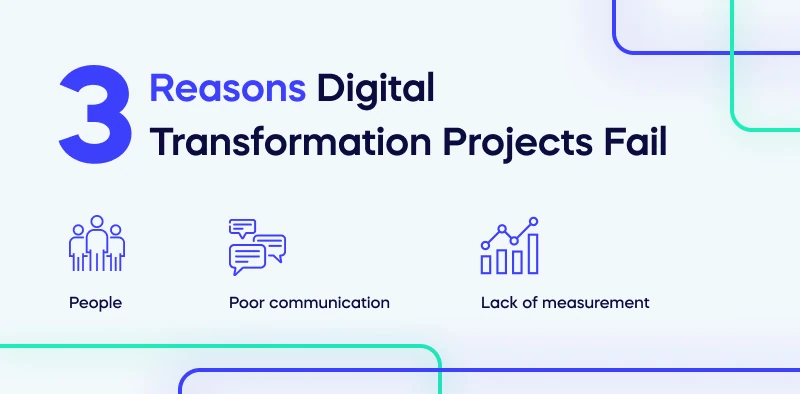
People
People are the essential ingredient in achieving digital transformation. It is paramount to remember that culture and people represent one of the six most important pillars for a successful endeavor; without proper focus, your aspirations will come to naught.
Poor communication
It is not enough to simply announce a digital transformation initiative. Leadership needs to take the time to communicate why and how the changes are happening and provide actionable guidance for it to succeed.
Lack of measurement
To ensure a successful digital transformation, you need to first define what success looks like for your business. While standard key performance metrics (KPIs) can be used to measure progress, these will not suffice if how you do business is changing. Therefore, new KPIs must be set to monitor any transformation effects accurately and efficiently.
How to Get Started with Digital Transformation in 6 steps
The key to a successful digital transformation is change management. It starts with leaders who must create and communicate a clear vision, roadmap, and objectives that define success.
Follow the following steps to unlock the full potential of digital transformation and keep your project on track:
- Create a clear vision and roadmap – Ensure everyone understands what you are trying to achieve and why.
- Implement change management – Encourage people to embrace the changes associated with digital transformation projects.
- Utilize technology appropriately – Invest in the right technology, including digital collaboration tools, analytics, and more.
- Establish proper KPIs – Measure progress using standard and custom metrics to ensure success.
- Monitor the project closely – Constantly check and monitor the progress of your digital transformation program against objectives to ensure it is on track.
- Continuously innovate – Keep pushing forward, experimenting, and evolving to stay ahead of the competition.
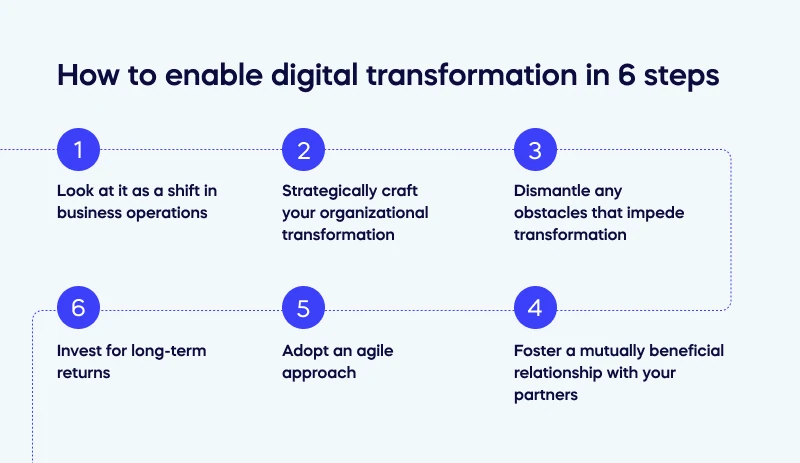
Properly planning your digital transformation project and considering these steps can ensure your program is successful. With the right strategy in place, you will be well on your way to achieving the results you desire.
Digital transformation trends 2023
Digital transformation trends in 2023 are set to revolutionize how businesses operate and interact with customers, and they are mainly in the technology aspect.
Matthew Higham, CDO, Microsoft UK
Words like cloud, digital, and AI have all become buzzwords, and everybody latches onto them. And there’s a curve of disillusionment that follows afterward. The CDO role will slowly disappear over the next ten years because more and more people within the organization will own the digital agenda as part of their normal traditional role and become much more technology focused.
We’ve outlined several important trends impacting businesses in the coming years:
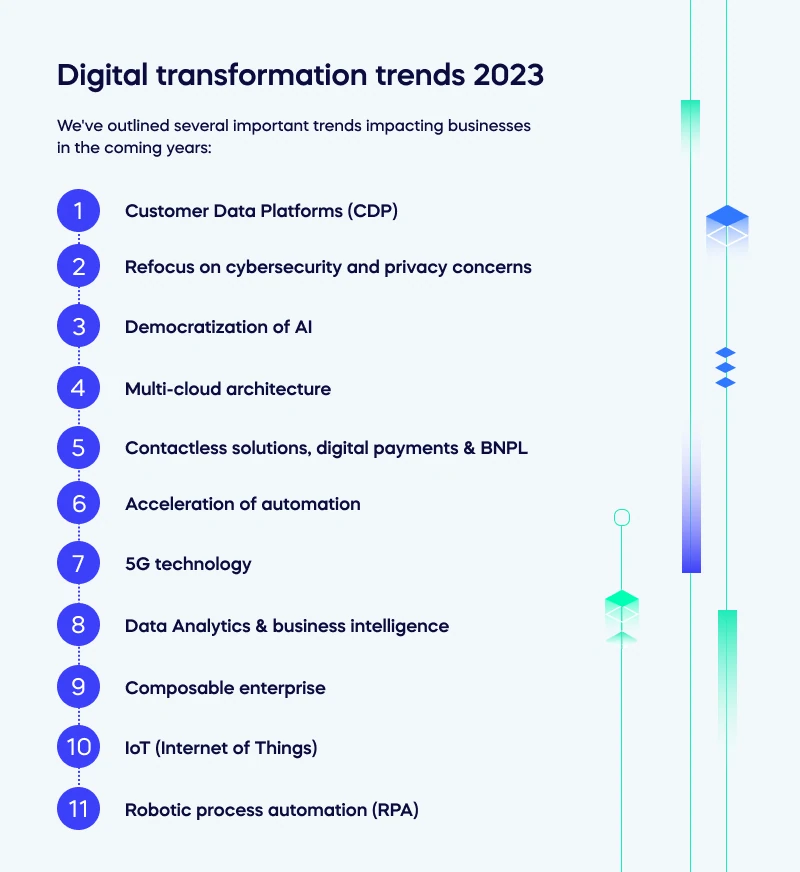
Customer Data Platforms (CDP) – This has been among the most widely discussed topics in marketing circles lately. Customer data platforms (CDPs) are quickly becoming a powerful tool for businesses because they provide a centralized platform for collecting and managing customer data.
Refocus on cybersecurity and privacy concerns – Data security and privacy have become increasingly important as laws like the GDPR, CCPA, and other regulations emphasize protecting user data. CDPs are great for helping businesses manage customer data, but they also come with certain security and privacy risks.
Democratization of AI – Using artificial intelligence AI and machine learning to automate marketing decisions is increasingly important in customer engagement. AI can help marketers to segment customers and target them more effectively.
Multi-cloud architecture – Adopting a multi-cloud architecture is becoming more popular as companies seek to optimize resources, reduce costs and speed up application development. Companies can better manage and deploy their applications by using multiple cloud services.
Contactless solutions, digital payments & BNPL – The pandemic forced many companies to rethink how they interact with customers and communicate with them during these times. As a result, we’re seeing an increase in contactless solutions, digital payments, and buy now pay later (BNPL) options.
Acceleration of automation – Automation is becoming increasingly important to boost efficiency and reduce costs. Companies are investing in automation solutions such as robotic process automation (RPA) to automate mundane tasks and reduce manual labor.
5G technology – 5G technology is quickly becoming the standard for communication, offering faster speeds and more reliable connections. This technological advancement will open up new business possibilities, from better customer engagement to increased productivity.
Data Analytics & business intelligence – Data analytics and business intelligence are essential for businesses to make data-driven decisions. Companies must understand customers’ behavior and trends to make more effective decisions.
Composable enterprise – Hyper-specialization has led companies to construct composable enterprises, making them more agile and better able to adapt and innovate. The idea that digital capabilities can be composed of existing apps and no-code solutions, rather than being built from scratch each time, is reshaping how companies develop and build their architecture.
IoT (Internet of Things) – The Internet of Things is a system of connected devices capable of transmitting and exchanging data without human intervention. There are so many things we use daily that are equipped with sensors and exchange data with other devices to facilitate the best user experience.
Robotic process automation (RPA) – Robots are spreading into analytics and decision-making, and RPA’s role in digital transformation includes accelerating tasks while ensuring greater accuracy and operational efficiency. Overall, it frees up human resources for higher-level jobs.
